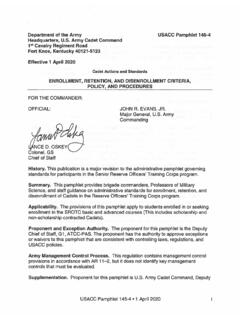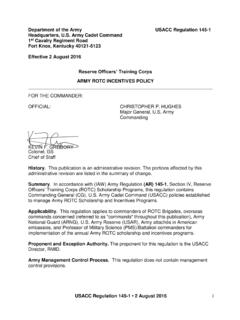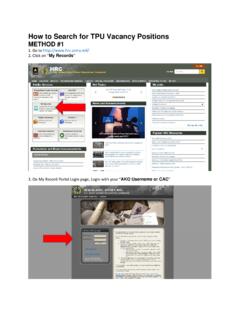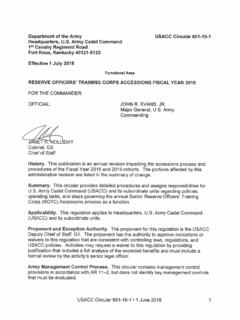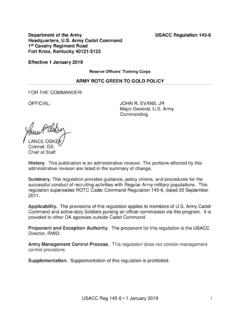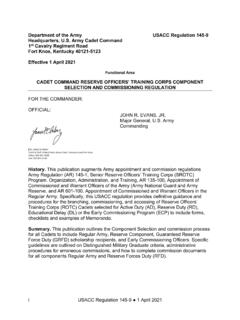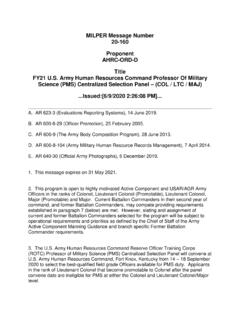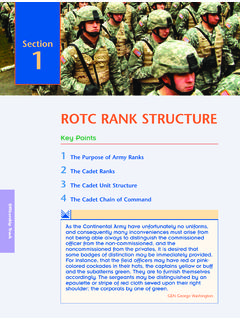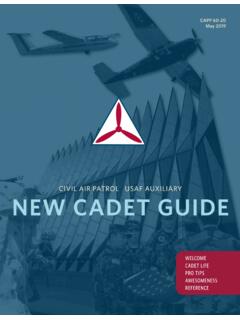Transcription of U.S. Army Cadet Command
1 Army Cadet Command Talent Based Branching Handbook USACC G1, Accessions and Standards Division 2021 History. This is a new publication that covers the Talent Based Branching process. Historically, this information was imbedded in the annual USACC Accessions Circular and Accessions-related Operations Orders. Summary. This handbook provides detailed procedures for Cadets and Cadre on how to establish a Talent Based Branching (TBB) account, make branch selections, build an accessions file, request a Branch for Active Duty Service Obligation (Branch ADSO) and volunteer for branch detail. It outlines the various aspects of the TBB system, as well as instructions for the total Accessions file used during branch selection.
2 Suggested Improvements. Users are invited to send comments and suggested improvements on DA Form 2028 (Recommended Changes to Publications and Blank Forms) directly to HQ, USACC, ATTN: ATCC-PA, Fort Knox, KY 40121-5123. Distribution. Distribution is intended for HQ USACC and its subordinate units. Distribution is in electronic format only. Contents Purpose - .. 4 Chapter 1 - The Accessions Cohort .. 4 1-1. Accessions Zone .. 4 1-2. Talent Based Branching (TBB) Defined .. 4 1-3. The Three Components of Talent Based Branching .. 5 1-4. TBB Website .. 5 Chapter 2 - Cadet Roles and Responsibilities .. 6 2-1. Cadet /ECP 2LT Responsibility .. 6 2-2.
3 Branch and Component Education .. 7 2-3. Cadet Self Assessment and Talent Assessment Battery .. 10 Chapter 3 - The Cadet File .. 12 3-1 Components of the Cadet File .. 12 3-2 Entering Branch 15 Chapter 4 - TBB Resources .. 18 Chapter 5 Cadre Roles and Responsibilities .. 18 5-1. Roles and Responsibilities .. 18 5-2. Cadet Talent Evaluation .. 21 5-3 Reporting Tools .. 21 Purpose - The purpose of this handbook is to outline and describe Talent Based Branching (TBB). This includes branch selection by the Cadet , navigating the TBB website, Cadre and Cadet responsibility, and a variety of tools to assist the user at all levels. Chapter 1 - The Accessions Cohort 1-1.
4 Accessions Zone a. All Cadets and Early Commission Program (ECP) 2 LTs who have successfully completed Advanced Camp and will graduate with a baccalaureate (or higher) degree and/or commission during the Fiscal Year (FY) make up that year s cohort. The cohort typically consists of the main body of accessions during May and December, end of camp commissionees, and those competing via an out-of-cycle board. For example, the FY22 cohort includes all Cadets/ECP 2 LTs that will graduate and /or commission and access between 1 October 2021 and 31 September 2022. b. Contracted Cadets that earn a baccalaureate degree during the time indicated above are part of the accession year group and are not permitted to pursue a Master s degree unless applying for Educational Delay IAW USACC Circular 601-xx-1 ( xx equals the current fiscal year the circular covers and is updated annually).
5 A baccalaureate degree is the minimum required degree to receive a commission from ROTC. 1-2. Talent Based Branching (TBB) Defined a. The USACC TBB Program meets the needs of the Army by shaping Cadet preferences toward branches in which they are most likely to excel while ensuring each Army branch receives the distribution of talent it requires. Similar to efforts at the other sources of commissioning, USACC s program helps cadets identify their unique talent profiles through self-assessment, standardized testing, and cadre evaluations. It also provides a foundation for understanding how those talent profiles fit with the talent requirements of each of the Army s basic branches.
6 In creating final branch assignments, USACC will combine Cadet talent data with Basic branch metrics to support the Army s move toward career cycle talent management focused on building a more ready and lethal force. TBB closely resembles the AIM process currently in place for officers in that the Cadet provides a talent resume` and interviews with the desired branch. The branches then vote the Cadet records and provide the branching board a rating of Most Preffered, Preffered, or Least Preferred. b. USACC s TBB Program will be an ongoing process throughout a Cadet s ROTC experience. Cadre will assist Cadets in aligning their branch preferences with their individual talent strengths.
7 Additionally, in assessing how well each Cadet s initial branch assignment meets the needs of the Army, the Regular Army Branching Board will have the authority to reassign Cadets to branches for which they are a better talent fit. However, if we as Cadre are mentoring and educating our Cadets while simultaneously our Cadets are self-reflecting and developing, branch reassignment should be minimal. 1-3. The Three Components of Talent Based Branching a. The three components of TBB are: (1) The Cadet File. Each Cadet /ECP 2LT will consolidate relevant information about his/her interests, extracurricular activities, ROTC experience and performance into a single online branching resume.
8 (2) The Talent Assessment Battery (TAB). The TAB is a series of cognitive and non-cognitive tests designed to assess individual talents as measured by Cadet s experiences, attitudes, personality traits, behaviors, and interests. The results are provided to the Cadet /ECP 2LT and Cadre to assist them as they reflect on their strengths and weaknesses, and consider the branches for which they may best fit. TAB results will also contribute to Cadet talent scores used by the Branching Board during the branching process. (3) The Cadet Talent Evaluation (CTE). The CTE is completed by Cadre as an assessment of an individual Cadet s talent, strengths, and weaknesses (as observed over time).
9 USACC Cadre will complete a CTE on each Cadet in accordance with the Operation Order. The feedback from the CTE assists Cadets in identifying their talent strengths and weaknesses, which shape their developmental plans and inform their branch preferences. In addition to influencing the feedback Cadets receive, USACC may use the CTE results during the Branching Board. 1-4. TBB Website a. Access to the TBB website is restricted and requires a Common Access Card (CAC). Cadets must be in a valid contracted status to obtain a CAC. The TBB website is found here: b. Restricted Access (Contracted Cadets, CAC-access required). This restricted access section of the website will allow Cadets to populate their respective Cadet files.
10 Information in these files will be both top-fed from CCIMM, as well as user-fed by the individual Cadets. Cadets/ECP 2 LTs will have the opportunity to update their individual files as necessary. Currently, Cadets will have to upload all transcript data (courses taken and grades received). This website will also provide Cadet self-assessment tools as well as allow mentor input by Cadre. Collectively, the information on this website provides a critical platform which will inform the various elements of the program. Specifically this site has the following purposes for Cadre and Mentors: (1) Cadre: Validate files Submit CTE Mentor Cadets Make board recommendations (2) Mentors: Mentor Cadets and make board recommendations c.

